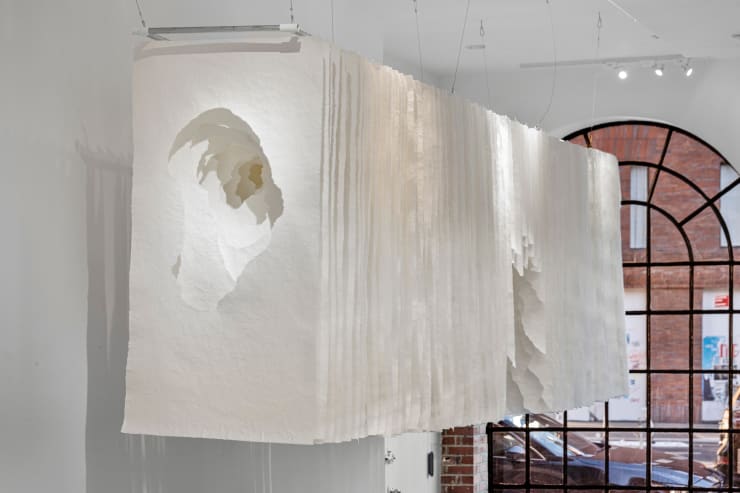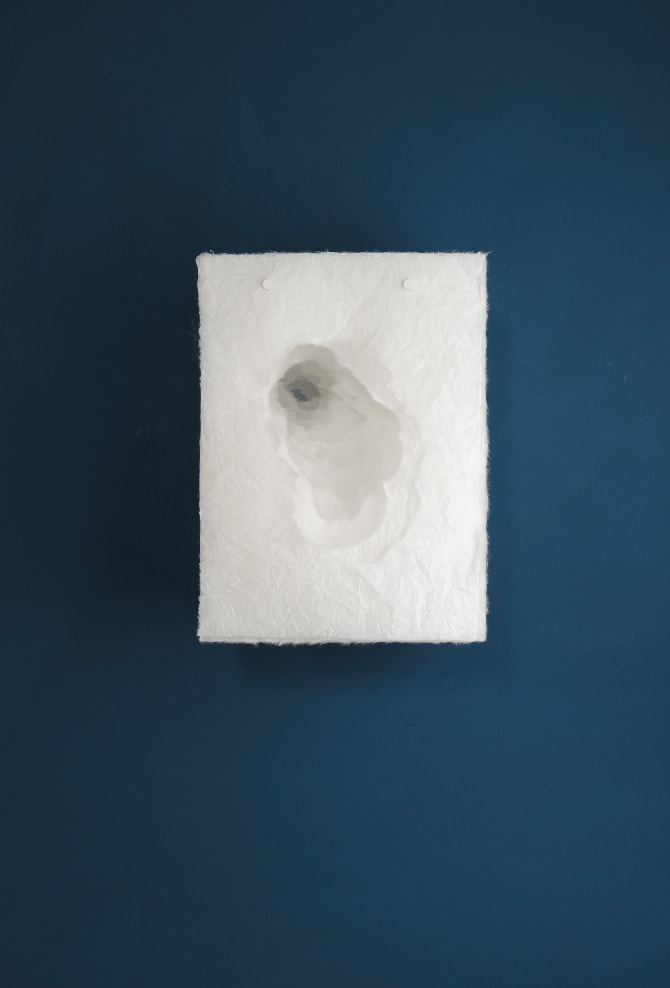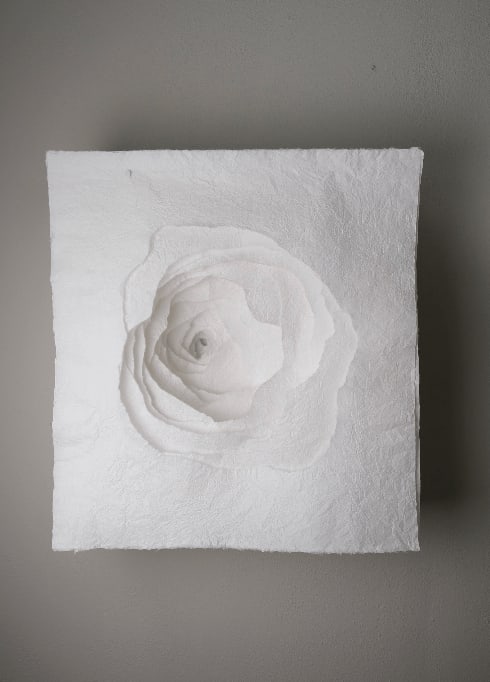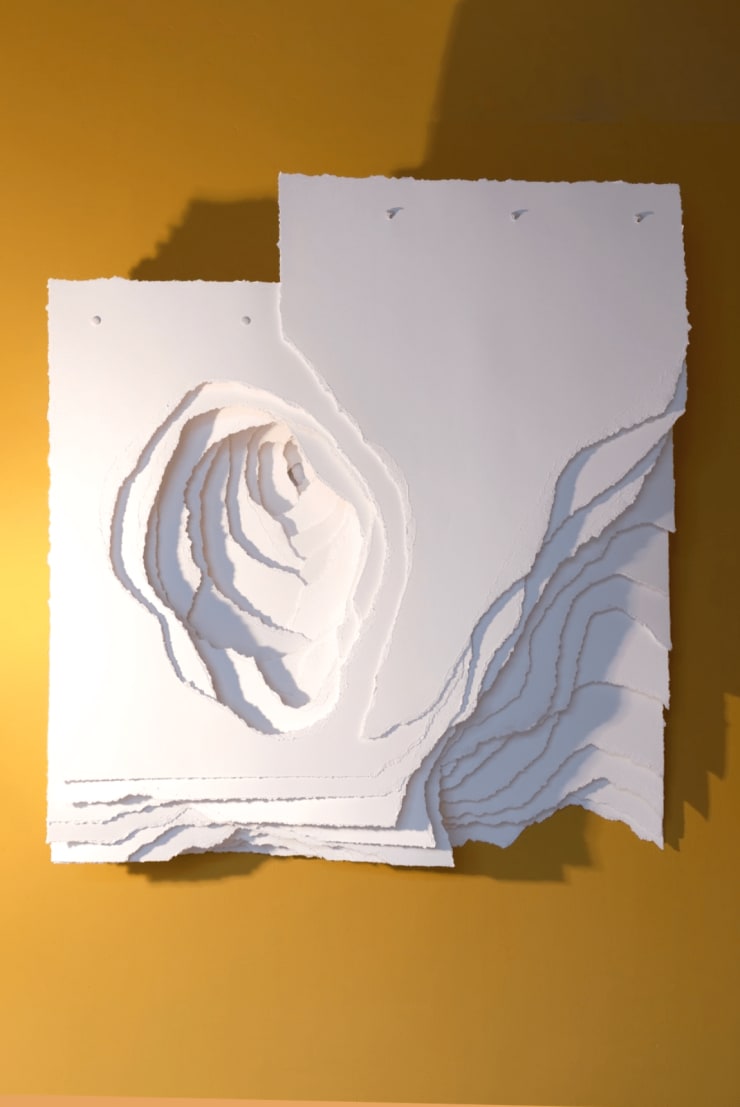Angela Glajcar: Floating in Space (Extended)
“Torn Hanji paper creates space poetry.” - Angela Glajcar
Friedrichs Pontone is delighted to present a collection of new works by renowned German artist, Angela Glajcar. Glajcar transforms large sheets of paper into layered sculptures that she often suspends from the ceiling or walls to engage with light, air, and perspective. These are born from her signature technique that she calls "terforation," a portmanteau of "terra" and "perforation."
The exhibition also celebrates the upcoming launch of Glajcar's catalogue raisonné, documenting her works from 1997-2004.
Angela Glajcar is an illustrious artist who sculpts with paper. By tearing, layering, and puncturing, she transforms the material into complex structures that question perspective and fragility. Her work has an ethereal quality, as light and shadow unite within her sculptures, creating otherworldly beauty.
All works in the exhibition are derived from Glajcar's technique, "Terforation," a portmanteau of "terra" and "perforation. Her series "Terforation'' (2005-present) consists of site-specific installations of paper sheets with hand-torn sections, each one presenting a cavernous void that evokes natural landforms. Works from this series have been exhibited in museums like the National Museum of Women in the Arts and MOCA Jacksonville, where Glajcar presented a monumental piece with 150 sheets of paper. In 2023, Austrian museum Landesgalerie Niederösterreich held a solo exhibition of her work, titled Dream Catcher.
Paper is a material steeped in historic cultural association. An age-old technology, in its artisanal, fine-art iteration, it is virtually unchanged in its method of production. Seen commonly in Glajcar's works is the use of Hanji paper (한지). A traditional handmade Korean paper, Hanji is made from the inner bark of a flowering plant called Paper Mulberry, sometimes referred to as Tapa Cloth Tree. Due to the chemical makeup of the Paper Mulberry, Hanji is considered extremely durable, despite having a silky, lightweight finish. Evidence of Hanji dates back to the Han Dynasty, which in ways allowed China's papermaking processes to spread throughout Asia. The earliest societal utilization of Hanji is seen in archives of the Three Kingdoms period (57 BCE-668 CE), in which the paper was used to transcribe histories and applied to paper crafts. The translucent nature of Hanji was appreciated early, as it was used to fabricate greenhouses during the Joseon period (1392-1910). The paper proved successful in maintaining light, humidity, and temperature. In recent decades, Hanji paper has been mostly prized for its uses in artistic, ceremonial, and conservation practices.
Glajcar began experimenting with Hanji in 2021, fascinated by how its properties differ from Western paper. She was drawn to its translucent quality, as light became an integral part of the work itself. Depending on ambient lighting, the works can drastically be altered, featuring an ever-changing element. Glajcar's use of Hanji paper only further pronounces her sculptures, as individual fibers and construction are visible to the naked eye.
Glajcar's technique is revolutionary. By taking an ordinary material, she transforms it into a medium with movement, shadow, and reflectiveness. Her process maximizes the raw physicality of paper and sculpts it to portray this best.
-
 Angela Glajcar2021-048 Terforation, 2021Hanji paper 89g, torn, wire, metal mounting55 1/8 x 29 1/2 x 196 7/8 in
Angela Glajcar2021-048 Terforation, 2021Hanji paper 89g, torn, wire, metal mounting55 1/8 x 29 1/2 x 196 7/8 in
140 x 75 x 500 cm -
 Angela Glajcar2024-016 Terforation, 2024Hanji Paper 34g, torn, metal mounting and plastic14 1/8 x 10 5/8 x 7 1/8 in
Angela Glajcar2024-016 Terforation, 2024Hanji Paper 34g, torn, metal mounting and plastic14 1/8 x 10 5/8 x 7 1/8 in
36 x 27 x 18 cm -
 Angela Glajcar2024-018 Terforation, 2024Hanji Paper 89g, torn, metal mounting and plastic15 x 13 3/4 x 8 5/8 in
Angela Glajcar2024-018 Terforation, 2024Hanji Paper 89g, torn, metal mounting and plastic15 x 13 3/4 x 8 5/8 in
38 x 35 x 22 cm -
 Angela Glajcar2024-017 Terforation, 2024Hanji Paper 34g, torn, metal mounting and plastic19 3/4 x 14 1/8 x 7 1/8 in
Angela Glajcar2024-017 Terforation, 2024Hanji Paper 34g, torn, metal mounting and plastic19 3/4 x 14 1/8 x 7 1/8 in
50 x 36 x 18 cm -
 Angela Glajcar2024-019 Terforation, 2024Hanji Paper 89g, torn, metal mounting and plastic15 x 13 3/4 x 8 1/4 in
Angela Glajcar2024-019 Terforation, 2024Hanji Paper 89g, torn, metal mounting and plastic15 x 13 3/4 x 8 1/4 in
38 x 35 x 21 cm -
 Angela Glajcar2024-020 Terforation, 2024Paper 200g, torn, metal mounting and plastic
Angela Glajcar2024-020 Terforation, 2024Paper 200g, torn, metal mounting and plastic
18 1/2 x 13 x 8 5/8 in
47 x 33 x 22 cm -
 Angela Glajcar2024-021 Terforation, 2024Paper 200g, torn, metal mounting and plastic18 1/2 x 13 3/8 x 8 5/8 in
Angela Glajcar2024-021 Terforation, 2024Paper 200g, torn, metal mounting and plastic18 1/2 x 13 3/8 x 8 5/8 in
47 x 34 x 22 cm -
 Angela Glajcar2024-022 Terforation, 2024Paper 200g, torn, metal mounting and plastic18 1/2 x 13 x 8 1/4 in
Angela Glajcar2024-022 Terforation, 2024Paper 200g, torn, metal mounting and plastic18 1/2 x 13 x 8 1/4 in
47 x 33 x 21 cm -
 Angela Glajcar2024-027 Terforation, 2024Hanji Paper 89g, torn, metal mounting and plastic26 3/4 x 18 1/2 x 6 7/8 in
Angela Glajcar2024-027 Terforation, 2024Hanji Paper 89g, torn, metal mounting and plastic26 3/4 x 18 1/2 x 6 7/8 in
68 x 47 x 17.5 cm -
 Angela Glajcar2024-026 Terforation, 2024Hanji Paper 89g, torn, metal mounting and plastic29 1/2 x 28 x 10 5/8 in
Angela Glajcar2024-026 Terforation, 2024Hanji Paper 89g, torn, metal mounting and plastic29 1/2 x 28 x 10 5/8 in
75 x 71 x 27 cm -
 Angela Glajcar2023-38 Terforation, 2023Paper 400g, torn, metal mounting and plastic65 x 59 7/8 x 13 3/8 in
Angela Glajcar2023-38 Terforation, 2023Paper 400g, torn, metal mounting and plastic65 x 59 7/8 x 13 3/8 in
165 x 152 x 34 cm












